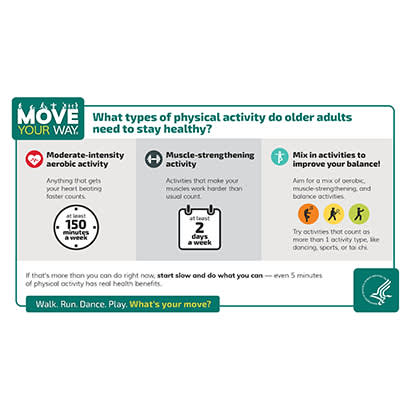
For an enhanced digital experience, read this story in the ezine.
Physical activity is a key component of healthy aging — with a range of benefits, from improved ability to perform activities of daily living to reduced risk of dementia and other health benefits. Park and recreation agencies have a positive influence on how older adults can engage in physical activity by offering programs and services to support individuals as they age.
The Physical Activity Guidelines for Americans Midcourse Report: Implementation Strategies for Older Adults (Midcourse Report) highlights community spaces as key settings for increased physical activity among older adults. This recommendation aligns with NRPA’s Active Parks! Initiative and the Community Guide.
How Much Physical Activity Do Older Adults Need?
According to the Physical Activity Guidelines for Americans, older adults should aim for at least 150 minutes of moderate-intensity aerobic activity, two days of muscle-strengthening activity, and multicomponent physical activity (which combines aerobic, muscle-strengthening and balance activities) each week.
Park and recreation professionals can help older adults find ways to move that fit their interests and abilities. It all adds up — so meet people where they are and help them build up to more activity over time.
Helping Older Adults Define Moderate-Intensity Aerobic Activity
Different physical activities may challenge individuals in different ways, so consider using The Talk Test as a simple way to measure relative intensity. When using relative intensity, people pay attention to how physical activity affects their heart rate and breathing. As a rule of thumb, a person doing moderate-intensity aerobic activity can talk, but not sing, during the activity. A person doing vigorous-intensity activity cannot say more than a few words without pausing for a breath.
Key Findings From the Midcourse Report
The Midcourse Report outlines evidence-based strategies that individuals working with older adults, such as park and recreation professionals, can use to help boost physical activity levels.
Modes of Delivery for Physical Activity Strategies
How a strategy is delivered influences its impact. Park and recreation professionals can utilize face-to-face (in-person or virtual) approaches and phone calls to support older adults through direct interaction and offer education and motivational support. Sharing print materials — like Move Your Way® handouts — can complement in-person and phone contact by allowing individuals to reread the content later.
Behavior Change Strategies
Behavior change approaches, like cognitive behavioral strategies and physical activity counseling, can increase physical activity self-efficacy and influence physical activity behaviors among older adults.
Cognitive behavioral strategies include increasing physical activity knowledge or awareness, goal setting, self-monitoring (through trackers or journals), barrier identification and problem solving, and social support.
Physical activity counseling involves providing tailored physical activity guidance through conversations and print materials and utilizes a variety of cognitive behavioral strategies.
Consider reaching out to local healthcare providers to make sure they’re aware of the programs offered through park and recreation agencies to help patients find physical activity opportunities in the community.
Physical Activity Programs
Physical activity programs that focus on lifestyle-based activity or structured exercise are effective ways to help get older adults more active. Evidence-based structured exercise programs, like Enhance®Fitness or Walk With Ease, provide personalized or group instruction; lifestyle-based programs help empower older adults to incorporate physical activity throughout the day. Both types of programs can utilize behavior change strategies in addition to physical activity or exercise plans.
Take Action
Numerous evidence-based programs exist to support older adult physical activity. Explore federally-supported programs that can be implemented in park and recreation settings in the Midcourse Report appendix or through Active People Healthy NationSM, and help more older people get active.
Alison Vaux-Bjerke, MPH, MCHES, is Physical Activity Advisor; Malorie Polster, MPH, CHES, is Physical Activity Advisor; and Katrina Piercy, Ph.D., R.D., ACSM-CEP, FACSM, is Director of the Division of Prevention Science, at the Office of Disease Prevention and Health Promotion (ODPHP) within the U.S. Department of Health and Human Services (HHS).


